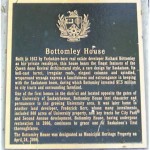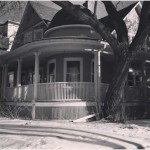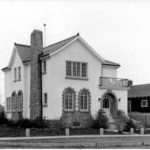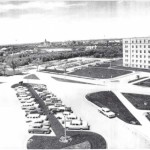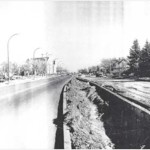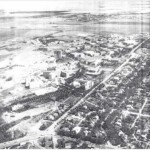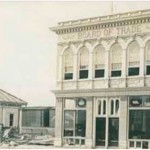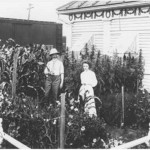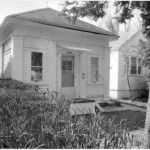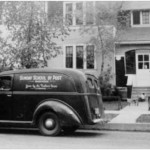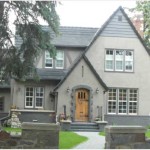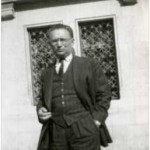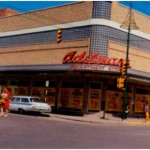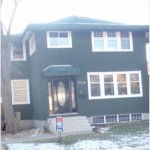Bottomley House
1118 College Drive
The iconic house is located at 1118 College Drive across from the University of Saskatchewan Memorial Gates. The house was home to prominent businessman Richard Bottomley, an important figure in Saskatoon history as he invested $1.5 million in city tracts and surrounding farmland.
The home was constructed between 1912 and 1915 and was one of the first houses built in Varsity View. From 1918 until 1930, Frederick Ervin Kerr and his wife Florence occupied the house. Like Richard, Frederick was also a prominent businessman, having formed the firm J.C. Drinkle and Co. with J.C. Drinkle. One of Frederick’s many investments included 800 acres of University property and city tracts for the development of City Park and Second Avenue.
In 1948, the house was purchased by Lillian Pattison and her husband Robert. It then became known as the Pattison house. When Queen Elizabeth visited Saskatoon in 1978, the appearance of the house was improved as it was along the Queen’s automobile route. Bottomley House was designated a Municipal Heritage Property on April 26, 2006.
This information was collected from the following sources:
– Meewasin Valley Authority (1999). Saskatoon Heritage Buildings Manual.
– City of Saskatoon (2012). Bottomley House. Retrieved from
http://www.saskatoon.ca/DEPARTMENTS/Community%20Services/PlanningDevelopment/DevelopmentReview//HeritageProperties/Pages/BottomleyHouse.aspx
Prescesky Residence
1138 Elliott Street
The residence was constructed in 1931. The original tenant of this house was Leon Prescesky, manager of Saskatoon Contracting and owner of Home Comfort Fuel. Leon lived in this house with his wife from 1931 to 1946. From 1946 to 1969, Mayor Sidney Buckwold and his wife Clarice lived in this home. At the time of its construction, the house was one of the highest price per square foot homes in Saskatoon. It has unique features such as stone-trimmed fan-arched windows, an iron balcony, and stone chimney.
This information was gathered from the following source:
– Clark, L. (August 1983), Prescesky Property, Meewasin Valley Authority.
College Street Houses
Widening of College Street
Up until 1964, eight houses were located along the north side of College Street. The University of Saskatchewan owned four of these properties, while the other four were private residences. In 1964, the initiative to improve Highway 5 led to the widening of College Street.
College Street changed from consisting of one traffic lane each way to having three traffic lanes each way. As a result of the widening of College Street in 1964, each of the eight houses on the north side were either demolished or moved to a different location. Most of the houses that were removed, except for some owned by the University, were ordered by the City to be moved to a location outside of the City.
In 1964, the name College Street changed to College Drive.
The following are accounts of the College Street Houses.
504 Clarence Avenue North:
The City of Saskatoon purchased the property from the owner for $40,000. The property was then demolished and the City paid $350.00 for the demolition of the structure. The house was demolished by November 1, 1964.
Source:
– COS Archives. File no. 1078-0397. Streets and Lanes, 1963-1964. Purchase of Property,
504 Clarence Avenue Letter dated April 17, 1964.
1011 College Street:
The City was paid $200.00 by the owner to remove the property from the lot. It was moved outside of the City limits by October 1, 1964.
Source:
– COS Archives. File no. 1078-0397. Streets and Lanes, 1963-1964. Bendel Letter dated August 26, 1964.
1015 College Street:
The City was paid $1200.00 by the owner to remove the property from the site. The property was removed to a location outside of the City limits by October 1, 1964.
Source:
– COS Archives. File no. 1078-0397. Streets and Lanes, 1963-1964. Siemens Letter dated
August 26, 1964.
1021 College Street
The property was owned by the University of Saskatchewan. An individual paid $1500.00 to remove the building and relocate it to another location in the City. Unlike the other houses ordered to be removed, this property was permitted to move to another location within the City limits. However, similar to 1031 College Street, this property was eventually demolished. The owner of the property was paid $100.00 by the City to have it demolished by October 15, 1964.
Sources:
– COS Archives. File no. 1078-0397. Streets and Lanes, 1963-1964. Scherr Letter dated
August 26, 1964.
– COS Archives. File no. 1078-0397. Streets and Lanes, 1963-1964. Fortosky Letter dated
September 15, 1964.
1023 and 1025 College Street:
Both of these properties were owned by the University of Saskatchewan. The City of Saskatoon purchased 1023 College Street from the University for $21,000. The property was then bought by the University of Saskatchewan from the City for $4000. 1025 College Street was owned by the University of Saskatchewan. Both 1023 and 1025 College Street were to be relocated to the University Grounds by October 1, 1964.
Sources:
– COS Archives. File no. 1078-0397. Streets and Lanes, 1963-1964. Widening of College
Street Purchase of Property- Lots 26 & 27, Block 15, 1023 College Street Letter dated June 10, 1964.
– COS Archives. File no. 1078-0397. Streets and Lanes, 1963-1964. Pringle Letter dated
August 26, 1964.
1029 College Street:
The owner was paid $11,830.00 by the City of Saskatoon. The structure was purchased from the City by another individual for $200.00 and moved off the lot. The house was removed from the City by October 1, 1964.
Source:
– COS Archives. File no. 1078-0397. Streets and Lanes, 1963-1964. Widening of College
Street, Lot 23, Block 15, 1029 College Street Letter dated May 22, 1964.
1031 College Street:
The owner was paid $11,360.04 by the City of Saskatoon. Originally, this property was supposed to be moved outside city limits for $25.00. However, the house ended up being demolished. The City paid $200.00 for the demolition. The house was removed from the lot by October 15, 1964.
Source:
– COS Archives. File no. 1078-0397. Streets and Lanes, 1963-1964. Widening of College
Street Purchase of Lot 22, Block 15, 1031 College Street Letter dated June 9, 1964.
Board of Trade House
1022 Temperance Street
This house was built in 1907 as the location for the Saskatoon Board of Trade. The house, seen beside the Board of Trade building in the photo to the right, was originally located on First Avenue. At this location, Board of Trade member F. Maclure Sanders tended to a garden beside the Board of Trade house. The garden consisted of tobacco, hemp, and cayenne peppers in an effort to convince newcomers of Saskatoon’s mild climate.
In 1909, the house was moved six feet closer to the curb and in 1920, it was moved to its present location of 1022 Temperance Street. The Board of Trade house was designed by Neil Stewart and constructed by Osborn and Brooks. The house had four pilasters on each side, several windows, and a metal roof.
Since becoming a residential building, the metal roof was replaced, two windows were removed, a kitchen was added to the rear, and a bedroom was added. The awnings and frieze reading “Board of Trade” were also removed.
Teacher’s Hostel
1110 Elliott Street
This building has a rich history in the Varsity View neighbourhood. From 1913 until 1925, this building was used as a teacher’s hostel. The establishment was built by Thomas E. Farley and designed by architects Thompson and Crockart.
The laying of the building’s cornerstone occurred on October 10, 1913.
In 1909, Bishop Lloyd (first Principle of Emmanuel College in Saskatoon and then Bishop of Saskatchewan), had persuaded the Ladies Association of the Commonwealth and Continental Church Society to fund the immigration and training of women teachers for government schools in Western Canada. This was part of the movement known as the Fellowship of the Maple Leaf. The movement started in 1917 in England by Bishop Lloyd. The goal of the fellowship was to provide accommodations for teachers in the newly settled areas of the Prairie Provinces. By the end of the 1920s, nearly 600 teachers had been recruited from England. Through fundraising and anonymous donors, many fellowship hostels, churches, and hospitals were able to be built in Saskatchewan and Alberta.
There were a few reasons behind why the location on Elliott Street was chosen for the hostel. First, it was close to Emmanuel College, making cooperation between the college and the hostel easier. The small distance between the hostel and the college also allowed for the hostel to house students and teachers from Emmanuel College, a role it would take on in its later years. The location of the hostel was also tied to the location of the Normal School. Prior to 1921, the Normal School inhabited temporary locations including Nutana Collegiate, Buena Vista School, Qu’Appelle Hall, Emmanuel College, and St. Mary’s School. Most of these were located near the University, so the hostel’s location on Elliott Street was quite close. Originally it was thought that the Normal School would find a permanent location within University Grounds. However, in 1921, the Normal School opened at a permanent location of Avenue A (Idylwyld Drive). In need of moving closer to the Normal School, the Teachers’ Hostel was relocated from Elliott Street to 101-31st Street West. The teacher’s staying at the building on Elliott Street moved to this new location.
From approximately 1926 until 1974, the building on Elliott Street was known as Emmanuel Annex, a place for faculty and students of Emmanuel College. By this time, the Commonwealth and Continental Church Society had taken full responsibility for the work of Emmanuel College. The Commonwealth and Continental Church Society was an Evangelical society that concentrated on ministering to settlers.
From approximately 1944 until 1959, the building was also home to the Sunday School by Post. Sunday School by Post started in 1905 and its aim was to meet the needs of 10 to 16 children who could not attend Sunday School regularly. In 1959, Sunday School by Post work was transferred by the Bishop of Saskatoon to the newly purchased Synod House.
After 1974, the building became a private residence and remains that way today. The original building was demolished in 2011 or 2012 to make way for a new building.
This information was gathered from the following sources:
– Elliott Street House Played Important Role in Anglican History, Saskatoon Sun, December 28, 1997.
– Fellowship of the Maple Leaf (n.d.). Early Days. Retrieved from http://www.mapleleaf.org.uk/page2.htm
– Hutchinson, T. (1997). 1110 Elliott Street Saskatoon, SK. Saskatoon, SK.
Nathan Adilman House
1137 Elliott Street
The house was home to Nathan Adilman. He arrived in Saskatoon in 1919 from Kyiv, Ukraine. His brothers Max and Harry formed a partnership in 1920 which established Adilman’s Department Store, formerly located at Avenue B and 20th Street West. Nathan became the sole owner of the department store in 1937. When Nathan passed away, his son Jack took over the store’s operations until it closed in 1976.
The house was built in 1931. Architects Webster and Gilbert designed the house and W.A. Peberdy built the home.
Adilman Drive in Silverwood Heights is named after the Adilman family.
This information was gathered from the following sources:
– City of Saskatoon (2014). Varsity View Local Area Plan Final Report.
– Duerkop, J. (2000). Saskatoon’s History in Street Names. Saskatoon:Purich Publishing Ltd.
– Henderson’s Saskatoon Directory, 1976.
Frank S. Dunn House
1128 Elliott Street
The house was built in 1926 and was home to Frank S. Dunn. He was the owner of Dunn’s Limited, one of the largest men’s clothing stores between Winnipeg and Vancouver. The department store was located at 154 2nd Avenue South from 1949 until 1954.
Frank and his wife Liliah Dunn lived at this residence from 1926 until 1962. In 1978, a wing was added to the east side of the house and the second floor was converted into a two-bedroom apartment.
This information was gathered from the following sources:
– Henderson’s Saskatoon Directory, 1926-1962.
– Photograph PH-97-148 by J. Howard Richards courtesy Saskatoon Public Library- Local History Room. Finding aid (Note).
Angus Mowat House
1004 15th Street East
The house was originally located at 908 Saskatchewan Crescent East, but was recently renovated and moved to its current location of 1004 15th Street East. The house was home to Angus Mowat and his family. Among many other things, Angus was the first professionally trained librarian at the Saskatoon Public Library. His son Farley, is a well known Canadian author and environmentalist. Arthur Silver Morton, founder of the Saskatchewan Archives Board, also lived in this house.
This information was gathered from the following source:
– City of Saskatoon (2014). Varsity View Local Area Plan Final Report.
